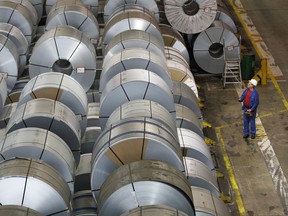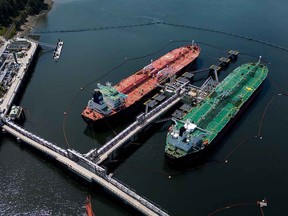Expert says Canadian steel could take a bigger hit compared to Canadian aluminum.
Article content
United States President Donald Trump signed orders imposing 25 per cent tariffs on all steel and aluminum imports “without exceptions or exemptions” on Monday evening.
Article content
Article content
“If we make it in the United States we don’t need it to be made in Canada,” Trump said in the Oval Office where he signed two proclamations closing existing loopholes and exemptions to restore his 2018 tariffs on steel and hike tariffs on aluminum.
Advertisement 2
Article content
“We’ll have the jobs, that’s why Canada should be our 51st state.”
Canada is bracing for these tariffs on March 12, amid Trump’s threats of the broader tariffs that were temporarily paused but could still take place.
What happened last time Trump imposed steel and aluminum tariffs?
Walid Hejazi, an associate professor of international business at the Rotman School of Management, said Trump’s preoccupation with steel and aluminum comes from his view that the United States needs a strong manufacturing base.
However, 25 per cent tariffs on steel and aluminum exports from other countries means that anything American manufacturers produce using these metals now becomes more expensive as well.
“So, when the U.S. tries to export anything that has steel or aluminum in it, it’s now more expensive,” Hejazi explained, adding that American producers may simply move their production outside of the U.S.. “This is counterproductive, and that’s why the last time they did this, the Americans actually (lost) jobs.”
In 2018, during Trump’s first tenure in the White House, the U.S. imposed 25 per cent tariffs on Canadian steel and 10 per cent tariffs on Canadian aluminum. Canada retaliated with matching tariffs on American steel and aluminum as well as on various other products from the U.S..
Article content
Advertisement 3
Article content
Economists Kadee Russ and Lydia Cox estimated the 2018 steel and aluminum tariffs resulted in at least 75,000 job losses across the U.S. manufacturing industry by mid-2019.
However, the tariffs hurt Canada too, with exports of steel products to the U.S. plunging nearly 40 per cent in June 2018 (the first month U.S. tariffs were implemented) and exports of aluminum cut by more than half, reaching their lowest level in over a decade in May 2019.
What will be the impact on Canada?
Hejazi explained that, with Canadian imports becoming more expensive in the U.S., Canada could lose its market share of steel and aluminum to U.S. producers. As a result, Canadian producers will either start laying off workers or slashing their prices and becoming unprofitable.
“It’s going to hurt all those people in the Canadian steel and aluminum industry significantly,” warned Hejazi. “It’s going to hurt a lot.”
Ontario and Quebec could be disproportionately affected by tariffs, as the former is home to six of Canada’s 13 steel plants. Hamilton has one of the highest concentrations of steel manufacturing activity in Canada, which includes major steelmakers and steel product manufacturers, such as Stelco Inc. and ArcelorMittal Dofasco Inc.
Advertisement 4
Article content
Quebec exports 2.9 million tonnes of aluminum to the U.S., accounting for about 60 per cent of aluminum used in the country.
Fen Osler Hampson, professor of international affairs at Carleton University and co-chair of the Expert Group on Canada-U.S. Relations, believes Canadian aluminum might withstand the tariffs better than Canadian steel. About half of all aluminum used in the U.S. is imported, with Canada its number one supplier.
How might they affect American steel production?
Although Trump says these tariffs will encourage domestic production, “U.S.-based smelters, even running at full capacity, cannot produce nearly enough metal to meet demand,” Aluminum Association president and chief executive office Charles Johnson said in a statement on Feb 1. “It would take billions of investment over decades to make the United States fully self-sufficient for its metal needs.”
Hampson said that because demand for aluminum is fairly inelastic, U.S. companies will have to continue to import aluminum, pay the tariffs and pass on the higher costs. While aluminum requires a large amount of energy for it to be produced, hydroelectricity is both plentiful and cheap in Canada.
Advertisement 5
Article content
“I think there’s virtually no prospect of substitution in the short or medium term by American producers, because these are comprehensive tariffs, they’re not just against Canada,” explained Hampson. “They’re against everyone, unlike the last round.”
When it comes to competition from imports the U.S. could receive from other countries, Hampson said the silver lining is that American tariffs aren’t just directed at Canadian imports this time. He suggested there’s a possibility that these tariffs could make Canadian industries more competitive, especially with the falling exchange rate.
How much steel and aluminum does Canada send to the U.S.?
United Steelworkers (USW) said that the two economies are highly integrated with $20 billion worth of steel traded between Canada and the U.S. every year. Canada imports 39 per cent of its steel from the U.S. and exports 94 per cent of its production there.
In 2024, Canada exported $15.9 billion worth of aluminum to the U.S. and imported $4.1 billion in American aluminum.
“Trump’s tariffs are a direct attack on workers and communities,” said Marty Warren, USW national director for Canada, in a statement. “We’ve been through this before and we know these kinds of reckless trade measures don’t work, and hurt workers, destabilize industries and create uncertainty across the economy on both sides of the border.”
Advertisement 6
Article content
Hampson explained that steel and aluminum are intermediary goods and are used across various manufacturing sectors across the U.S., including auto. According to a note from Fitch Ratings, Honda, General Motors, Nissan and Stellantis have the highest exposure to the U.S. tariffs due to their high share of vehicles imported to the U.S. from Mexico and Canada in their global sales.
“The (American) auto sector may just come to a grinding halt,” Hampson warned. “American manufacturers aren’t going to take this one lying down.”
How can Canada respond?
>Hejazi suggested Canada could look for markets in other countries, particularly those that have a strong manufacturing base but aren’t abundant in energy.
However, he acknowledged that steel and aluminum are heavy, and the transportation costs would be significant. The benefit of having the U.S. as a major trading partner is that it’s right next door, so it’s been much more cost-effective to transport goods across the border.
“We don’t have infrastructure to get this stuff to Asia,” Hejazi said. “So, the Americans have us trapped.”
Advertisement 7
Article content
Catherine Cobden, president and chief executive officer of the Canadian Steel Producers Association (CSPA), said in a statement that she was “deeply concerned” about Trump’s tariffs on steel and aluminum, calling for retaliatory measures.
However, Hampson thinks Canada shouldn’t respond too precipitously, pointing to the damage retaliatory tariffs could pose onto Canadian manufacturers.
“I would say work with the Americans,” he advised, highlighting how U.S. tariffs could hurt their own manufacturing base. “They’re going to scream the loudest, (so) help them make their case in the White House, in Congress, in the U.S. courts, and don’t run around like chickens with our heads cut off.”
Recommended from Editorial
-

Tariffs put steel and aluminum sector in familiar predicament
-

Tariffs have Canadian businesses rethinking exports
Speaking to reporters in Paris, Prime Minister Justin Trudeau said Canada will give a “firm and clear” response to the steel and aluminum tariffs, adding that his government would be working with Trump’s administration over the coming weeks “to highlight the negative impacts on Americans and Canadians of these unacceptable tariffs.”
Trudeau said there have been “initial conversations” with allies and, when asked whether Canada would retaliate with matching tariffs, responded “we hope it will not come to that.”
• Email: slouis@postmedia.com
Bookmark our website and support our journalism: Don’t miss the business news you need to know — add financialpost.com to your bookmarks and sign up for our newsletters here.
Article content
How will Trump’s tariffs on steel and aluminum impact Canada?
2025-02-11 18:22:12







